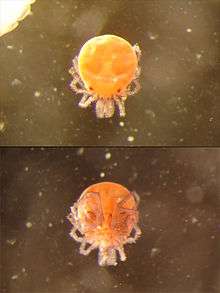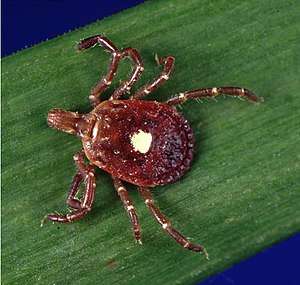Hydrachnidia
Hydrachnidia, also known as "water mites", Hydrachnidiae, Hydracarina or Hydrachnellae, are among the most abundant and diverse groups of benthic arthropods, composed of 6,000 described species from 57 families.[2] As water mites of Africa, Asia, and South America have not been well-studied, the numbers are likely to be far greater. Other taxa of parasitengone mites include species with semi-aquatic habits, but only the Hydracarina are properly subaquatic. Water mites follow the general parasitengona life cycle, which is characterized by parasitic, calyptostatic, and predaceous stages.[2] They are ubiquitous in nearly all freshwater habitats of every continent except Antarctica.[3] Typical habitats include streams and marshes, but may also be found in more obscure areas such as treeholes, hot springs, deep lakes and waterfalls. Some species have also adapted to marine environments.[4][1] Water mites are unusual among freshwater invertebrates in being colorful, with brilliant reds and oranges being most obvious, but they also display more subtle blues, greens and yellows. They are also unusual among all mites in that some lineages have movable, internalized eye lenses sunk deep within the tissues of the prosoma rather than being set on the surface of the cuticle.[5]
| Hydrachnidia | |
|---|---|
 | |
| Scientific classification | |
| Kingdom: | |
| Phylum: | |
| Class: | |
| Subclass: | |
| Order: | |
| Suborder: | |
| (unranked): | |
| (unranked): | Hydrachnidia |
| Superfamilies[1] | |
| |
| Synonyms | |
| |
.jpg)

Parasitism
Background
Larvae are the only water mite life stage to have parasitic relationships with other organisms. Upon location of a host, larvae pierce host integument with their chelicerae and feed on hemolymph until fully engorged or brushed off.[2] Common host groups include insects with aquatic or semi-aquatic juvenile stages, including, but not limited to, the Diptera (true flies), Odonata (dragonflies and damselflies), and Trichoptera (caddisflies).[6] It was originally believed that water mite larvae located hosts by accidental contact, but recent studies have found they likely utilize a combination of visual, tactile, and chemical cues.[2] Even though larvae are capable of sensing the presence of a nearby host, it has been suggested that they are unable to distinguish between host species, and rather select hosts solely based on spatial and temporal coincidence.[7] The abundance of water mites in a region, as well as prevalence and intensity of host infection, are impacted by a multitude of environmental and biological factors, and have shown great geographic variation.[8][9][10][11] In some cases, high infection intensities have significantly increased chances of host mortality and reduced fecundity.[12][13] Water mite larvae have been considered as a potential biological control agents, although low natural infection intensities warrant supplementation with other control strategies in order to be effective.[14]
Mosquitoes as hosts
The majority of water mites found parasitic on mosquitoes belong to two genera: Parathyas (Hydryphantidae) and Arrenurus (Arrenuridae).[15] The biology and ecology of these specific host-mite interactions have been well studied, likely due to the significant relevance of mosquitoes to human health.
Parathyas barbigera are among the most common mite species found parasitizing mosquitoes, especially those of the genera Aedes and Ochlerotatus. Their host range is likely much wider, as studies have detected P. barbigera parasitizing other dipteran families, such as Tipulidae (crane flies), Ptychopteridae (phantom crane flies), Chloropidae (grass flies), and Empididae (dagger flies).[15][7][8] These mites are typically abundant along the margins of temporary ponds, springs, streams, and seepage areas in North America and Europe. Nymphs and adults can be seen crawling and mating along substrate beginning in early Spring, soon after the recession of surface ice. Eggs are laid soon after the thaw, and larvae typically emerge and begin host seeking within 30–40 days. According to Mullen (1977), P. barbigera attach exclusively to female mosquitoes as they land near the water's edge to oviposit, which was supported by an extensive field study in which he observed zero mite larvae on 15,000 Aedes pupae, and dissection of parasitized females revealed them all to be parous. Mullen hypothesized that this life history strategy increased chances of mite survival two-fold because those parasitizing males would likely die before returning to a suitable adult habitat.[7] No literature was found discussing the impact of P. barbigera on mosquito physiology and survival.

Larval mites of the genus Arrenurus are also common ectoparasites of many mosquito species. In contrast to P. barbigera, Arrenurus mites are fully aquatic and prefer permanent habitats, such as swamps and marshes. Females lay eggs in protected areas hidden among the abundant vegetation of these habitats, and upon hatching, larvae can be found swimming throughout the upper water column in search of hosts.[16][17] Once an immature host is located, Arrenurus larvae loosely bind to their integument, and monitor them until the adult emerges. Host muscle contractions just prior to emergence stimulate mite larvae to move towards the ecydisal opening and attach to the host along intersegmental sutures on their thorax and abdomen. Differences in preferred attachment site between mite species appear to be related to differences in host emergence behavior.[16] Full larval engorgement takes approximately three days, during which they have the potential to significantly impact the health of their host.[12][13] In laboratory settings, the survival of Anopheles crucians mosquitoes parasitized by Arrenurus (Meg.) pseudotenuicollis was found to decrease from 23.32 to 6.25 days between those harboring the least and greatest numbers of attached mites respectively. Under similar conditions, infection intensities equalling 17-32 mites decreased the number of eggs laid by gravid An. crucians by nearly 100%. High mite loads also significantly decreased the fecundity of field-collected An. crucians, but to a lesser extent than those infected in the lab.[12] Similar consequences of high Arrenurus mite infection intensities were observed in other host-mite relationships. For example, Smith and McIver (1984) found that Arrenurus danbyensis loads of greater than 5 mites decreased the fecundity of Coquillettidia perturbans females by approximately 3.5 eggs per additional mite.[13] Even though Arrenurus mite larvae have been considered as potential biocontrol agents, unrealistic numbers would need to be released in order to prove effective on their own.[14]
References
- Di Sabatino, A., Gerecke, R., Martin, P. (2000). "The biology and ecology of lotic water mites (Hydrachnidia)". Freshwater Biology. 44 (1): 47–62. doi:10.1046/j.1365-2427.2000.00591.x.CS1 maint: multiple names: authors list (link)
- Proctor, Heather C.; Smith, Ian M.; Cook, David R.; Smith, Bruce P. (2015), "Subphylum Chelicerata, Class Arachnida", Thorp and Covich's Freshwater Invertebrates, Elsevier, pp. 599–660, doi:10.1016/b978-0-12-385026-3.00025-5, ISBN 9780123850263
- Di Sabatino, Antonio; Smit, Harry; Gerecke, Reinhard; Goldschmidt, Tom; Matsumoto, Noriko; Cicolani, Bruno (2007-12-18). "Global diversity of water mites (Acari, Hydrachnidia; Arachnida) in freshwater". Hydrobiologia. 595 (1): 303–315. doi:10.1007/s10750-007-9025-1. ISSN 0018-8158.
- "Encyclopedia of Life".
- Dabert, Miroslawa; Proctor, Heather; Dabert, Jacek (1 August 2016). "Higher-level molecular phylogeny of the water mites (Acariformes: Prostigmata: Parasitengonina: Hydrachnidiae)". Molecular Phylogenetics and Evolution. 101: 75–90. doi:10.1016/j.ympev.2016.05.004. ISSN 1055-7903. PMID 27150348.
- Smith, Ian M.; Cook, David R.; Smith, Bruce P. (2010), "Water Mites (Hydrachnidiae) and Other Arachnids", Ecology and Classification of North American Freshwater Invertebrates, Elsevier, pp. 485–586, doi:10.1016/b978-0-12-374855-3.00015-7, ISBN 9780123748553
- Mullen, Gary R. (1977-01-31). "Acarine Parasites of Mosquitoes Iv. Taxonomy, life history and behavior of Thyas barbigera and Thyasides sphagnorum (Hydrachnellae: Thyasidae)1". Journal of Medical Entomology. 13 (4–5): 475–485. doi:10.1093/jmedent/13.4-5.475. ISSN 1938-2928.
- Kirkhoff, Christopher J.; Simmons, Thomas W.; Hutchinson, Michael (February 2013). "Adult Mosquitoes Parasitized by Larval Water Mites in Pennsylvania". Journal of Parasitology. 99 (1): 31–39. doi:10.1645/ge-3105.1. ISSN 0022-3395. PMID 22924904.
- dos Santos, Emili Bortolon; Favretto, Mario Arthur; dos Santos Costa, Samuel Geremias; Navarro-Silva, Mario Antonio (2016-04-16). "Mites (Acari: Trombidiformes) parasitizing mosquitoes (Diptera: Culicidae) in an Atlantic Forest area in southern Brazil with a new mite genus country record". Experimental and Applied Acarology. 69 (3): 323–333. doi:10.1007/s10493-016-0045-2. ISSN 0168-8162. PMID 27085719.
- Jalil, Mazhar; Mitchell, Rodger (1972-08-01). "Parasitism of Mosquitoes by Water Mites1". Journal of Medical Entomology. 9 (4): 305–311. doi:10.1093/jmedent/9.4.305. ISSN 1938-2928.
- Lanciani, Carmine A. (June 1986). "Effect of the Water Mite Arrenurus pseudotenuicollis (Acariformes: Arrenuridae) on the Longevity of Captive Anopheles quadrimaculatus (Diptera: Culicidae)". The Florida Entomologist. 69 (2): 436–437. doi:10.2307/3494955. ISSN 0015-4040. JSTOR 3494955.
- Lanciani, C. A.; Boyt, A. D. (1977-08-20). "The Effect of a Parasitic Water Mite, Arrenurus Pseudotenuicollis1 (Acari: Hydrachnellae), on the Survival and Reproduction of the Mosquito Anopheles Crucians (Diptera: Culicidae)". Journal of Medical Entomology. 14 (1): 10–15. doi:10.1093/jmedent/14.1.10. ISSN 1938-2928.
- Smith, Bruce P.; McIver, Susan B. (June 1984). "The impact of Arrenurus danbyensis Mullen (Acari: Prostigmata; Arrenuridae) on a population of Coquillettidia perturbans (Walker) (Diptera: Culicidae)". Canadian Journal of Zoology. 62 (6): 1121–1134. doi:10.1139/z84-163. ISSN 0008-4301.
- Smith, BP (1983). "The potential of mites as biological control agents of mosquitoes". Biological Control of Pests by Mites. 37 (3): 79–85. doi:10.1111/j.1570-7458.1985.tb03488.x.
- Mullen, Gary R. (1975-04-30). "Acarine Parasites of Mosquitoes: I. A critical review of all known records of mosquitoes parasitized by mites1". Journal of Medical Entomology. 12 (1): 27–36. doi:10.1093/jmedent/12.1.27. ISSN 1938-2928. PMID 240027.
- Mullen, G. R. (1974). The taxonomy and bionomics of aquatic mites (Acarina: Hydrachnellae) parasitic on mosquitoes in North America. Entomology.
- Mullen, Gary (1976). "Water mites of the subgenus Truncaturus (Arrenuridae, Arrenurus) in North America". Search Agriculture Entomology. 6 (6).
External links
- "Introduction to Hydrachnidia". Soil & Water Conservation Society of Metro Halifax. 2006. Retrieved 27 December 2012.
